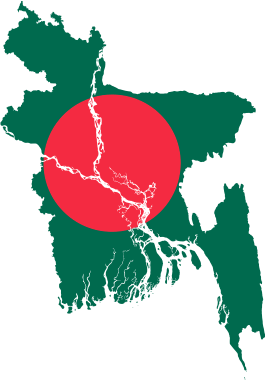Fakhruddin Mubarak Shah
Fakhruddin Mubarak Shah (Bengali: ফখরুদ্দিন মুবারক শাহ, Persian: فخر الدین مبارک شاه; reigned: 1338–1349) ruled an independent kingdom in areas that lie within modern-day eastern and southeastern Bangladesh, centered in Sonargaon.[1][2] He is also the first Muslim ruler to conquest Chittagong, the principal port of Bengal region in 1340 AD.[3]
Part of a series on the |
|---|
| History of Bangladesh |
 |
|
|
Ancient
|
|
Classical
|
|
Medieval
|
|
Modern
|
|
|
Related articles |
|
|
History
Fakhruddin's capital was Sonargaon.[1] It emerged as the principal city of the region as the capital of an independent sultanate during his reign.[4] His conquests of Comilla and Noakhali were followed by territorial gains to the north Sylhet and south Chittagong.[1] His military initiatives included a successful naval action against Sultan Alauddin Ali Shah of Lakhnauti.[1] Shah sponsored several construction projects, including a trunk road and raised embankments, along with mosques and tombs.[1] Ibn Batuta, after visiting his capital in 1346, described Shah as "a distinguished sovereign who loved strangers, particularly the fakirs and sufis."[1]
Ikhtiyaruddin Ghazi Shah, who according to historian Jadunath Sarkar was most probably Fakhruddin's son, succeeded him and ruled the independent Sultanate from Sonargaon till 1352.[2]
References
- Khan, Muazzam Hussain (2012). "Fakhruddin Mubarak Shah". In Islam, Sirajul; Jamal, Ahmed A. (eds.). Banglapedia: National Encyclopedia of Bangladesh (Second ed.). Asiatic Society of Bangladesh.
- Sarkar, Jadunath (1973) [First published 1948]. The History of Bengal. Volume II: Muslim Period, 1200-1757. Patna: Academica Asiatica. p. 96. OCLC 924890.
- "About Chittagong:History". Local Government Engineering Department, Government of Bangladesh. Archived from the original on 2014-11-03. Retrieved 2013-12-30.
- "Historic archaeological sites need to be preserved". The Daily Star. UNB. September 5, 2009. Retrieved 2013-12-23.
| Preceded by Bahram Khan |
Independent Sultan of Bengal 1338–1349 |
Succeeded by Ikhtiyaruddin Ghazi Shah |